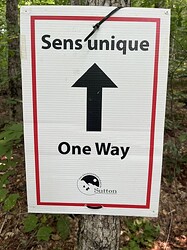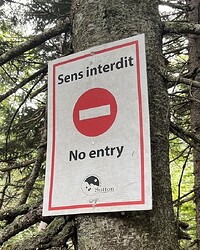I have yet to see a queue where people object other people in front of them backing up.
This aside, there seem to exist some exceptional situations with narrow hiking paths and similar, and full height turn stiles in built up environment, so the question is not whether these exist but how they should be tagged
Ticket gates enforce one way pedestrian traffic but because they are nodes, you can’t specify the direction on them. The only way to do this is by tagging the footpath through them as one way.
no, a turn restriction is more appropriate in this case ![]()
Thanks all for your comments.
The problem is, to you, the meaning is clear, any vehicle allowed to travel there can only go one way (i.e. the tag doesn’t apply to pedestrians). But to others, who mapped examples 1, 2, 3, 4, 5, and 6, the meaning was clear, any pedestrian allowed to travel there can only go one way. There are countless more examples.
A lot of people think the meaning is clear but we have different ideas what it means!
This is the core problem that the proposal is about. If we use oneway:foot and oneway:bicycle instead, it becomes much clearer.
It’s not uncommon in Germany that a footway allows considerate cycling, and this is a distinct legal concept from a shared-use path. This is an example (see the sign on the right in the picture). And often there’s one on each side of the road, and as a cyclist you have to use the one on the right side of the road. You can actually get a ticket for cycling in the wrong direction. Of course, pedestrians can use the sidewalk in both directions.
You can find a lot of them with @SomeoneElse’s Overpass query. This is what I find paradoxical about the current situation - some people say this is problem data and needs surveying and correcting and others say it’s perfectly fine to tag a footway with oneway and expect data consumers to realise they meant bicycles but not pedestrians.
I’m not asking anyone to start a mass retagging campaign. I am just saying, if next time you map something like this, you use oneway:bicycle instead of oneway, then it will be clearer. @Langlaeufer’s numbers show that for this scenario in Germany, this is already the slightly more popular option.
For me, it’s not just about the Wiki.
I think the “problem data” exists because people aren’t aware that oneway is ambiguous on footways, and we can point out better tags to them - for example in editor presets and validator warnings.
Right now, if you tag a footway in iD, it offers you the option to add the oneway tag, but it doesn’t explain what the oneway tag means (it doesn’t explain if it applies to pedestrians or only to vehicles).
I volunteer to make a pull request for id-tagging-schema removing oneway from the footway preset, and adding oneway:foot and oneway:bicycle instead, with clear explanations what they mean. This will encourage future mappers to choose a more specific tag, leading to less of the “problem data” being created. But I won’t do this unless I have the clear support of the community that this is a good idea. At the moment, some people prefer oneway:foot, others prefer foot:backward, and others argue that using oneway to mean pedestrians is completely fine. Can we agree which tag to use?
Don’t use oneway:vehicle yet!
There are only 62 uses until now. I guess nearly no software is supporting this at the moment.
You want to make things clearer you may safely add oneway=yes + oneway:foot=no
Perhaps I could have been clearer. Although oneway:vehicle=yes would be a reasonable extrapolations from vehicle=yes, I meant this more as oneway:{{VEHICLE_TYPE}}=yes. So replace {{VEHICLE_TYPE}} with bicycle or whatever other access tag vehicle type.
but for highway=pedestrian with vehicle=* I would still recommend to use oneway=yes for the vehicle part.
The more I think about it, the more I no longer want to deprecate oneway on pedestrian infrastructure and instead explicitly demand oneway:foot=yes/no if oneway=yes is present or if pedestrians should be effected.
This needs simply a check implemented in the editors and QS tools
highway=footway|pedestrian|steps + oneway=yes|-1 + !oneway=footway
only pedestrians oneway → oneway:foot=yes
only vehicle=oneway → oneway=yes + oneway:foot=no
vehicle and pedestrians oneway → oneway=yes + oneway:foot=yes
This hiking area in Québec has several one way trails to keep ascending and descending foot traffic separated. Examples:
- Way: Montée du Lac Spruce (95475343) | OpenStreetMap
- Way: Descente du Round Top (834841039) | OpenStreetMap
I hiked here last year and saw very clear one way signs. They look like this:
source: https://www.alltrails.com/trail/canada/quebec/lac-spruce-trail/photos
This small difference is not a good indicator. This result changes if I slightly change the request.
On footway oneway:bicycle is slightly leading
3347 x highway=footway + bicycle=yes|designated + oneway + oneway!=no
3792 x highway=footway + bicycle=yes|designated + oneway:bicycle + oneway:bicycle!=no
but on path oneway is clearly dominating
23578 x highway=path + foot=designated + bicycle=yes|designated + foot=designated + oneway + oneway!=no
7546 x highway=path + foot=designated + bicycle=yes|designated + foot=designated + oneway:bicycle + oneway:bicycle!=no
1834 x highway=cycleway + foot=designated + oneway + oneway!=no
469 x highway=cycleway + foot=designated + oneway:bicycle + oneway:bicycle!=no
628 x highway=pedestrian + ~bicycle~yes + oneway + oneway!=no
25 x highway=pedestrian + ~bicycle~yes + oneway:bicycle + oneway:bicycle!=no
1264 x sidewalk(:side):bicycle=yes + sidewalk(:side):oneway=yes|-1
0 x sidewalk(:side):bicycle=yes + sidewalk(:side):oneway:bicycle=yes|-1
I’ve given this some thought, and I think you might me onto something. This would be beneficial, because it’s just be another refinement on top of what we currently have, instead of deprecating oneway=* on certain highways. I like it ![]()
we talk globaly about this numbers of way with oneway=yes
57 482 x highway=path
16 044 x highway=footway
13 405 x highway=pedestrian
3 897 x highway=steps
overpass (pedestrians intrastructure with oneway!=no but no oneway:foot")
I come with these thesis:
- Avoid redefining tags

- The meaning of oneway must not change if the highway type or the access tags are changed. (-> also for highway=steps).
- oneway should apply only to vehicles (-> oneway:foot on steps and footways if pedestrians are effected).
- existing correct tagging for vehicles should continue to work. (no need to change oneway to oneway:bicycle or even more strange oneway:vehicle)
- Resolve unclear situations for pedestrians by explicitly tagging oneway:foot=yes/no/*
I think asking for oneway:foot=no in addition to oneway=yes is completely overkill, given that this exists only in very few occasions (some hiking trails in Poland and possibly elsewhere) while oneway restrictions on shared paths (or footways with permissions for some vehicles) are rather common. Additionally, oneway:foot is not based on traffic signs or rules but on individual “adhoc” signs, and these often are not actual oneways (where only one direction is forbidden and going back after having walked it for some even short stretch is forbidden), but rather no-entry rules at one end.
E.g. using oneway:foot for waiting queues is usually not factually correct, because you can walk back at any time before reaching the end of the queue.
Generally I still do not understand why almost everybody seems to want using oneway:foot=yes instead of foot:backward=no which is more beautiful semantically.
Then only errors warnings if oneway is used on a highway that it is not allowed for vehicle.
foot:backward=no is basically impossible to remember and I need to draw diagram to understand what it means, every time I see it.
while oneway:foot=yes is using common syntax and has a clear meaning
I would prefer a solution where we gradually start avoiding the “naked” oneway key for any highway usable by pedestrians. That is, use oneway:vehicle=yes for this situation. Plain oneway=yes would only used by vehicle-only roads such as motorways where there is no potential ambiguity.
We would therefore stop relying on the built-in assumptions which modes of transport a oneway=yes tag applies to and simply always make the mode of transport explicit if there is any potential doubt.
Yes on one hand this is nice but on the other this means retagging of 80000 ways and all routing applications needs to be adapted, even the non-pedestian ones.
Plain
oneway=yeswould only used by vehicle-only roads such as motorways where there is no potential ambiguity.
there are 2836 motorways with foot=yes and this is not even considering motorway_link, motorroad etc.
https://taginfo.openstreetmap.org/tags/highway=motorway#combinations
If we go this way there are 22.6 million ways to retag, and a lot of tools to change.
Note that oneway can also apply to equestrians, unlike oneway:vehicle (horse is not a vehicle in OSM hierarchy).
There is really no need to redefine the meaning of oneway (which would have massive consequences). Better focus the proposal on defining oneway:foot and when to use it.

